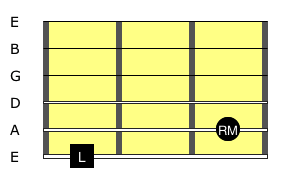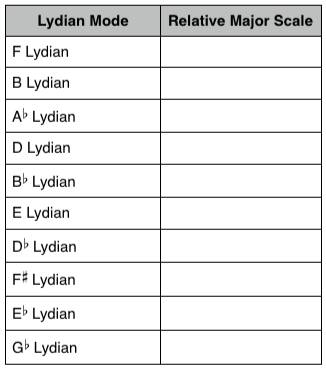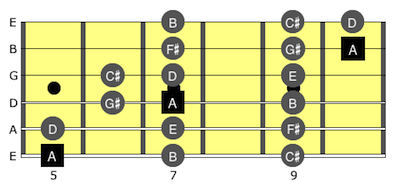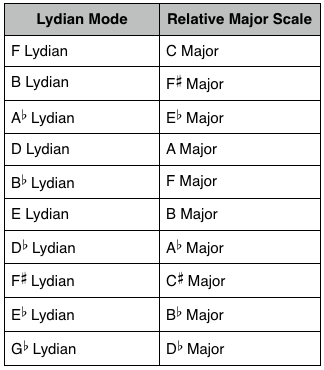As you were filling out the table from Understanding The Lydian Mode: Part 1, then you might have been getting a somewhat unsettling sense of déjà vu. The good news is that you’re not going crazy. 🙂 What you were probably noticing was the fact that each lydian mode has a major scale that contains exactly the same notes. This is quite an important thing to understand, so let’s delve deeper into it…
Relative Major Scales Of The Lydian Mode
It’s essential to know that every lydian mode has a relative major scale that contains exactly the same notes. To see what I mean, please check out the two scales below…
A Lydian Mode:

E Major Scale:

If you look closely at the scales above, you’ll probably notice the following two things…
- The A Lydian mode uses the same notes as the E Major scale.
- Both scales have the same key signature. (4 sharps).
This means that they are relative scales. In other words…
- A Lydian is the relative lydian mode of the E Major scale.
- The E Major scale is the relative major scale of the A Lydian mode.
Why Understanding Relative Major Scales Is Important
If you’re starting to explore the major scale modes, then you’re probably already very comfortable with playing the major scale. (If you aren’t, then you shouldn’t even consider starting to learn the major scale modes!). This is fantastic, because all the hard work you’ve put into learning the major scale will help you with soloing using the lydian mode. For Example: If you wanted to jam over the A Lydian backing track from the last lesson, you could use any E Major scale fingering that you currently know.
The cool thing is, that this approach works for any lydian mode that you might want to solo with. All you need to do, is work out the relative major scale of the lydian mode that you want to use. Once you’ve done this, then you can simply use the relative major scale fingerings to solo in the lydian mode. As you might imagine, being able to use major scale fingerings that you already know, can make the process of starting to learn the lydian mode far less overwhelming. Rather than thinking that you have to learn a whole bunch of new scale fingerings, you can just reuse the major scale fingerings you know in a new and sneaky way. 🙂
An Easy Way To Work Out Relative Major Scales
To work out the relative major scale of any lydian mode, all you need to do is find the fifth note of the lydian mode you want to use. Let’s take a look at an example of this now…
D Lydian Mode:

As you can see from the diagram above, the fifth note of the D Lydian mode is A. This means that the relative major scale of the D Lydian mode is the A Major scale. So if you wanted to jam in D Lydian, then you could use any A Major scale fingering that you know.
Although the method above is fairly straightforward, it does require having to work out the notes of the lydian mode first. While this isn’t a major problem, it can be a bit too slow if you’re jamming with other musicians and need to think very quickly. So here’s a really handy diagram that you might want to commit to memory now…

This fretboard diagram gives you a handy way of visualizing the relationship between the lydian mode and it’s relative major scale. To use this visualization method, all you need to do is follow these steps…
- Put your first finger on the root note of the lydian mode you want to solo with. (This is shown in the diagram with the box that has an L on it). For Example: If you wanted to play a solo using the G Lydian mode, you would put your first finger on the 3rd fret of the thick E-string.
- To find the relative major scale, put your third finger on A-string, two frets higher than your first finger. (I’ve shown this on the diagram using the circle with RM on it). For Example: If we stick with the example of G Lydian, your third finger should be on the note D on the A-string. This means that the relative major scale of G Lydian is D Major.
Work Out These Relative Major Scales
Using the method we’ve just talked about, please work out the relative major scales for the following lydian modes…

I’ll be giving you the answers after the next section of this lesson. So be sure that you fill out the table before reading any further. I know many people reading this lesson will disregard this sage advice, but I trust you’ll be one of the few diligent guitarists who don’t cheat. 🙂
Putting This Theory Into Practice
Let’s now look at a simple way of putting this music theory into practice. Please go get your guitar, and do the following steps
- Memorize the following D Lydian chord progression.

- Using any strumming pattern that you want, record yourself playing the chord progression for at least five minutes.
- Improvise over the chord progression using the relative major scale. Because the progression is in D Lydian, then this means that you can solo over it using any A Major scale fingering that you know. If you don’t know any scale fingerings for the A Major scale, then you can use the one I’ve shown directly below.

The Answers
Here are the answers for the table that you filled out earlier…

A Few Last Words
I hope you’ve found the two introductory lessons on the lydian mode helpful. I know we’ve only just scratched the surface, but at least you now have some idea on how the lydian mode is constructed, and how it sounds. If you really like the sound of lydian mode, then it’s definitely worth your time to explore it on a much deeper level.
Have fun!
Return To: Guitar Music Theory Lessons